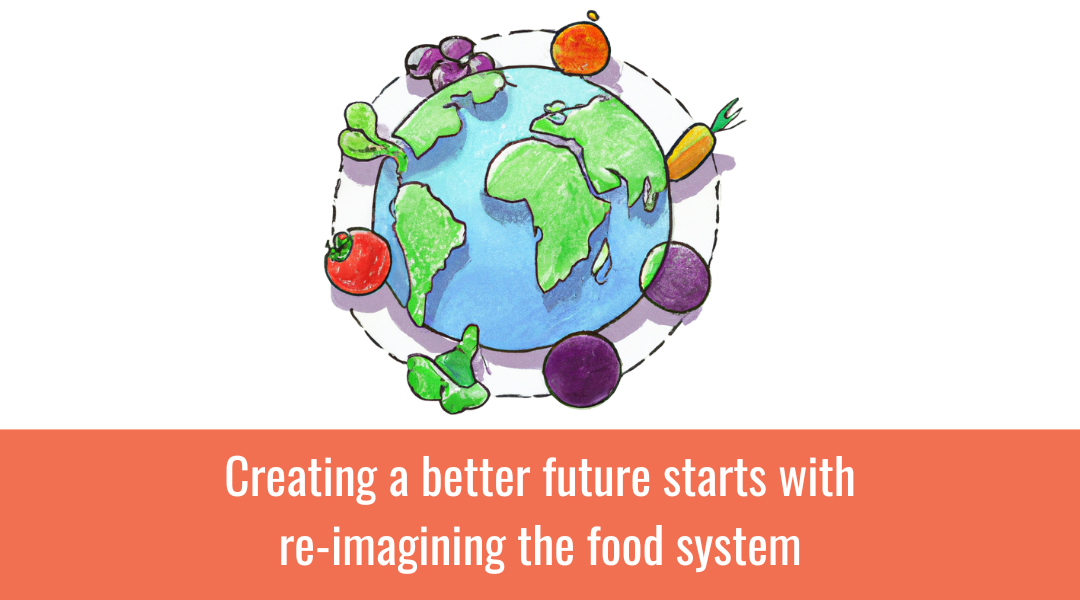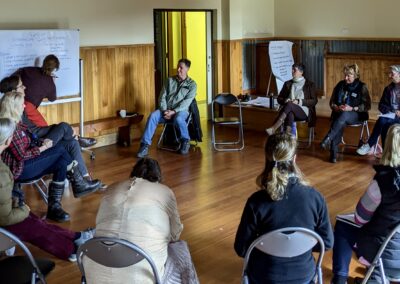Likely one third and potentially up to 42% of total greenhouse gas emissions are associated with the food system (Source: IPCC 6th Assessment Report – WG 3, Chapter 12, cross-sectoral perspectives, pg 4). The largest contribution of food systems greenhouse gas emissions was from agriculture but there are significant other contributions from land use change, energy use for food, food waste management and industrial processes (Source: our world in data, 2021). These pieces add up to a large chunk of our contribution to global warming. So why is food not front and centre in discussions about what can be done to fix the climate crisis?
How the food system contributes to global warming
Depending on how you measure it, the global food system accounts for between 25-42% of global greenhouse gas emissions (Source: IPCC; Our World In Data 2021 – see image below).
Key areas that emissions are coming from include:
- Land use and clearing forested land for agricultural use – 3.2 – 5.7 billion tonnes of CO2
- Agricultural production between – 7.1 to 8 billion tonnes of CO2
- Transport, Logistics and Packaging – between 2.6 to 3.1 billion tonnes of CO2
- Household food waste and cooking – an estimated 2.1 billion tonnes of CO2
(Source: Our World in Data 2022)

Everyone has a role to play in fixing our food system.
As Wendell Berry stated, ‘eating is an agricultural act’. We are all active participants in our food system and often don’t realise the influence we can have. In order to dramatically reduce greenhouse gas emissions, we (and we mean everyone! government, industry, farmers, households) need to apply a critical lens in imagining a better, fairer food system, and take action, where possible.
Reducing emissions on the land
Incorporate more trees on agricultural land
Agriculture was biggest source of land clearing in Australia during the period of 2010 – 2018, with 1.8 million hectares of land being cleared for grazing and a further 125,000 hectares being cleared for grazing modified pastures (Source: ABC 2020). As many regenerative farmers will tell you – it doesn’t have to be that way. You might be surprised to find out that under regenerative grazing systems, farmers have experienced higher yields while also restoring the habitat by planting trees. In one study, farmers saw an 11% yield increase of animals raised in silvopasture systems, a form of agroforestry where trees, forage, and the grazing domesticated animals are integrated in a mutually beneficial way.
Agroforestry systems have a higher capacity to sequester carbon than single crop or pasture systems, capturing more of light, nutrients and water and storing higher levels of carbon in the soil. In addition to this, many of the areas on Australian farms that have been cleared are not productive, and tree planting initiatives in these areas would help to restore habitats and reduce emissions.
Some positive measures are already being taken in this space. For instance, the National Landcare Program has provided $70 million of federal funding towards replanting 20 million trees between 2014-2020. To create lasting positive change, however, much more needs to be done. This investment represented 0.6% of the Federal Government’s annual revenue. If this amount was increased we could dramatically reduce emissions, for instance – over 373 metric tons of CO2 would be reduced by reforresting marginalised land and developing integrated shelter belts in Australia (Source: Ernst and Young 2021).
Reduce the need for animal feed through regenerative agriculture
According to one study, “Animal-derived foods provide about one-third of total human protein consumption but their production requires about 75% of arable land and 35% of grain resources, while contributing about 14.5% to total greenhouse gas emissions.” (Source: Sureson G, 2020) In Australia, 40% of grain is produced to feed animals in feedlots. This could be almost eliminated through agroecological approaches to animal production.
Find ways to reduce top soil erosion
Research suggests that 500kg of soil is lost per hectare in Australian Agriculture (Source: Koch et al, 2015 Monitor Soil Degradation or Triage for Soil Security? An Australian Challenge Journal of Sustainability 2015). This has a detrimental effect on biodiversity, nutrient quality and land productivity. Studies indicate that agro-ecological systems not only prevent soil loss,bute also increase the amount of carbon captured in the soil.
According to Serenity Hill from the Open Food Network, “ Measuring and preventing soil loss is not given enough attention in studies and policies that look at reducing our emissions. We need to factor this into future climate modelling and productivity scenarios, and focus on initiatives to hold soil together with perennial plants – building carbon above and below ground.”
Reducing emissions through changing our attitude to food
Food loss and food waste
It is estimated that globally, one-third of food produced for human consumption is lost or wasted – equating to approximately 1.3 billion tonnes per year. This equates to 10% of global greenhouse gas emissions generated from food that is never consumed.
The UN Environment Programme usefully notes the difference between food loss and food waste when we start to break down the enormity of the figure. Food loss occurs at the production, post-harvest, processing, and distribution stage and food waste often occurs at the retail and consumption stage of the food supply chain.
In Australia, 7.6 million tonnes of food loss and waste accounts for 3% of Australia’s annual greenhouse gas emissions (Food Bank 2022). This is largely an outcome of the ills of our current food system, for instance, a whopping 25% of fruit and vegetables produced never leaves the farm gate because the produce may not meet aesthetic or specification standards of contracts, and second or third grade produce becomes infeasible to harvest, pack and transport (Source: Australian Academy of Science).
Examples like Manto Produce and their apple chip-making technology demonstrate innovative and entrepreneurial solutions to reducing or designing out food loss and food waste, while also adapting to our rapidly changing climate. Stop Food Waste Australia has a bold strategy to halve food waste by 2030, we encourage you to check it out!
Cut down on junk food
Beyond food wastage, an estimated 33% of the cropland footprint of the average Australian diet is made up of discretionary food (e.g. junk food, alcohol). Reducing the amount of junk food produced would lead to a significant reduction in emissions, while leading to a significantly healthy population.
Minimise packaging
Every single piece of plastic ever made still exists and if you are shopping at a supermarket, it’s almost impossible to avoid. Globally, packaging accounts for between 0.6 – 1 billion tonnes of greenhouse gas emissions, every year (Source: Our World in Data 2022). These days there are many wonderful resources, tips and tricks available for how to avoid or reduce packaging in our everyday lives. Where you shop can also make a big difference to the amount of packaging ‘given’ to you with your food. For instance, if you are shopping at food hubs or farmers’ markets you’ll go home with far less packaging, and what you are given will usually use minimal packaging or be biodegradable.
Shop locally
Globally, food transport accounts for 0.8 billion tonnes of greenhouse gas emissions every year (Source: Our World in Data 2022). Much of the food we consume in Australia comes from interstate or international transport, and there are problems with this beyond the environmental impacts.
For instance, flooding in NSW and QLD has caused significant disruptions to our food supply, and food costs have risen exponentially. Supermarkets are dependent on long supply chains, and as a result are incredibly vulnerable to shocks to the supply chain.
Farmers’ markets, food hubs and food co-ops have demonstrated how local food systems with short supply chains prove to be resilient, as seen in our most recent pandemics and extreme weather events. It is now often cheaper to shop for fresh fruit and vegetables at a food hub than it is at a supermarket.
Choose food that has been produced in agro-ecological or regenerative production systems
Chemical fertilisers and pesticides have experienced widespread use in the last century, and are one of the main reasons that the earth’s productive top social is degrading up to 10x faster than it’s able to regenerate (The Guardian 2019) leading to one UN official saying that we only have 52 years of farming left if these rates continue.
Our reliance on chemical fertilisers account for a huge amount of the greenhouse gas emissions from agricultural production. Nitrate fertilisers take a huge amount of energy to produce and use about 1.5 percent of the global energy supply and 6 percent of the global natural gas (methane) supply with one study referencing that as much as 45% of energy use for conventional grain crop production stems from synthetic nitrogen production.
Many farmers and producers are turning to regenerative agricultural production methods as a way of improving soil quality, healing the land and reducing dependence on energy-intensive inputs. This leads to lower carbon emissions and often, much higher quality produce.
Your choices can create a more sustainable food system.
Everyone has a role to play in creating a more sustainable food system. Here are some of the ways that you can start making a difference.
Farmers and Producers:
- Organisations like the Australian Food Sovereignty Alliance and Farmers for Climate Action are advocating for positive change in this space.
- Organisations like Landcare and Trust for Nature in Victoria can assist with revegetation projects that build carbon and habitat.
- Attending events on agroecological farming such as agroforestry, regenerative grazing or low input cropping, or connecting with local, values-aligned producers will also help to increase your knowledge
- You might also want to consider getting listed on the Open Food Network
Consumers:
Where possible
- Try to buy products that use regenerative agriculture practices and/or are free from chemicals, pesticides and synthetic fertilisers.
- Seek out produce that is grown in your local region
- Opt for food that has no packaging, or is sustainable packaged (glass and paper over plastic).
You can easily find local producers on the Open Food Network, and use our filters to search for chemical free produce, or produce that was created using regenerative agricultural practices.
If you have the time and the inclination, you might also consider volunteering at a local community food enterprise. These organisations are powered by volunteers, and you’ll be making a big impact while meeting new people and accessing some awesome produce!
Latest Resources
Can we help?
Have an idea, a project or a question? Want help using the Open Food Network software? Get in touch and find out how we can help you with it.
Keep in touch
Join us
Create a listing, shop or group directory on the Open Food Network. Tell me more!

Read our Terms and conditions | Find us on GitHub
Open Food Network is a free and open source software platform. Our content is licensed with CC BY-SA 3.0 and our code with AGPL 3.
We take good care of your data. See our cookies policy
Open Food Network respectfully acknowledges the traditional custodians of the unceded lands on which we meet, work and live. We pay our respects to their Elders, past, present and emerging and acknowledge their deep spiritual relationship to country.





